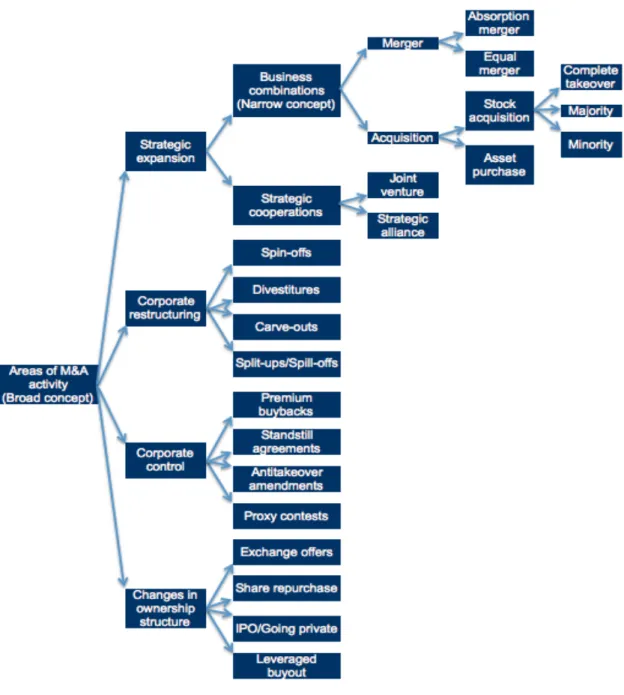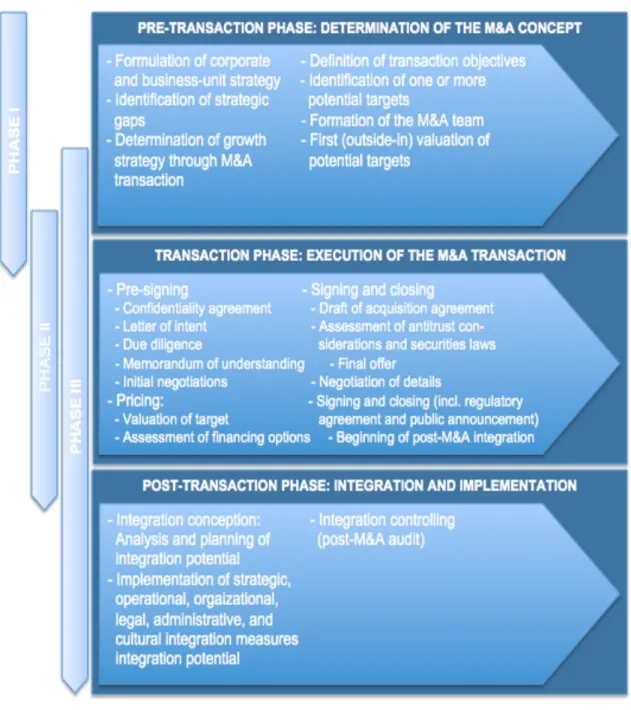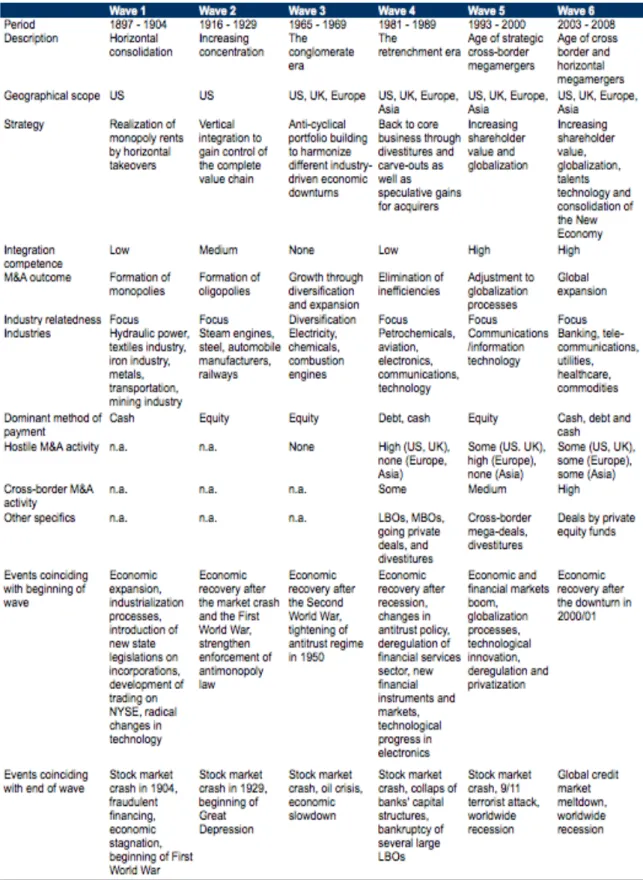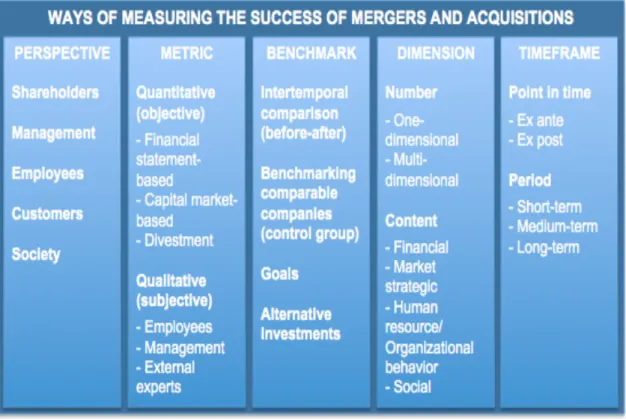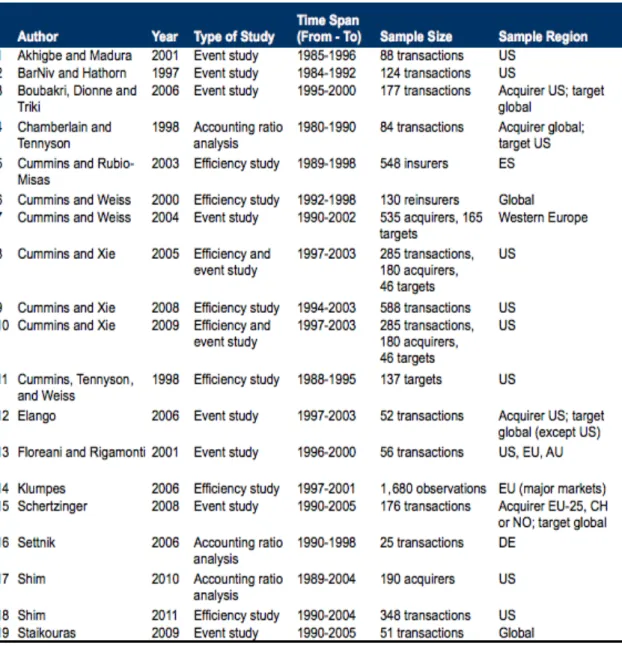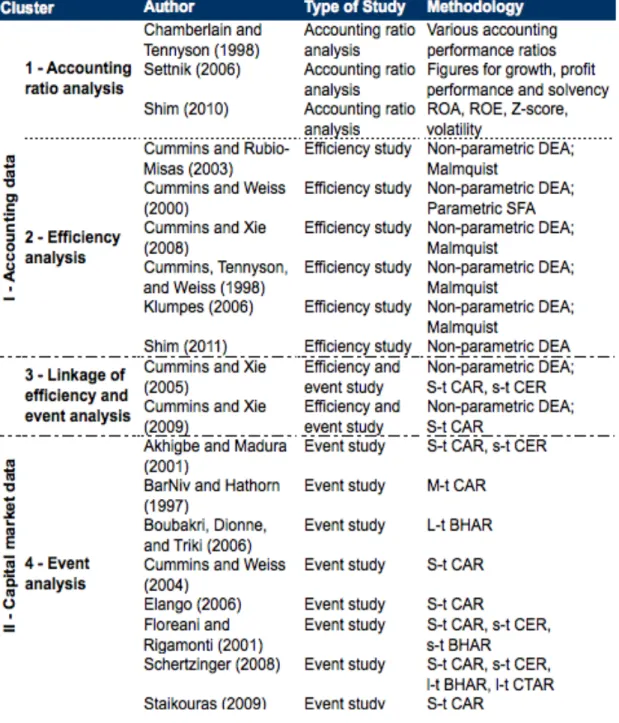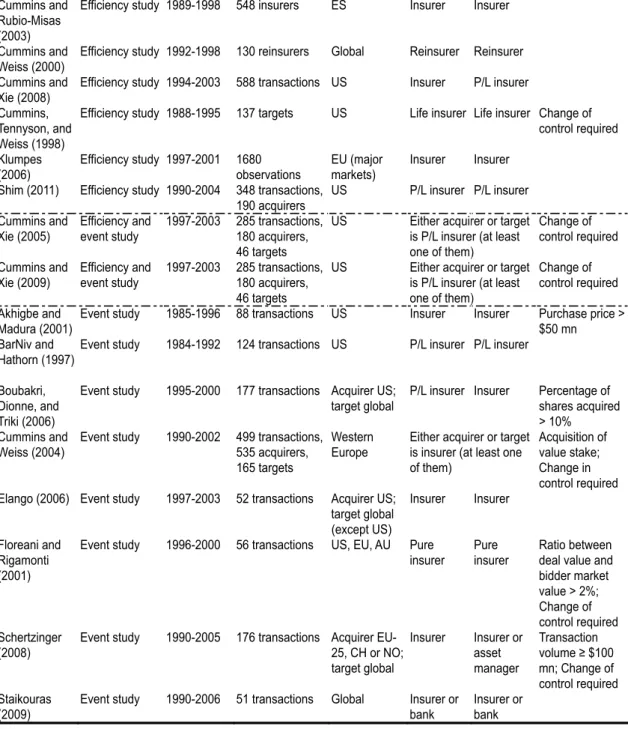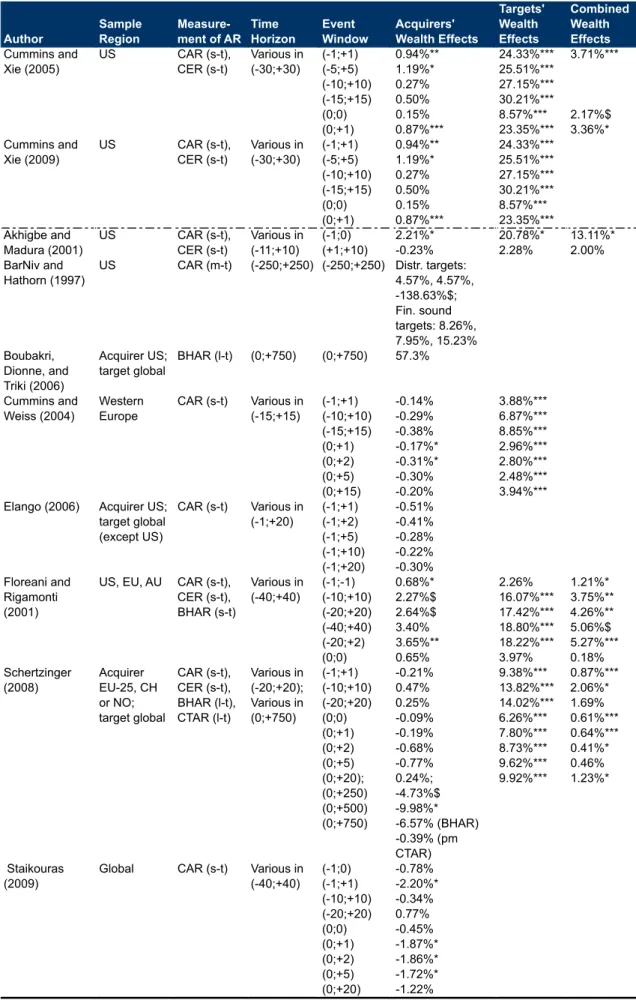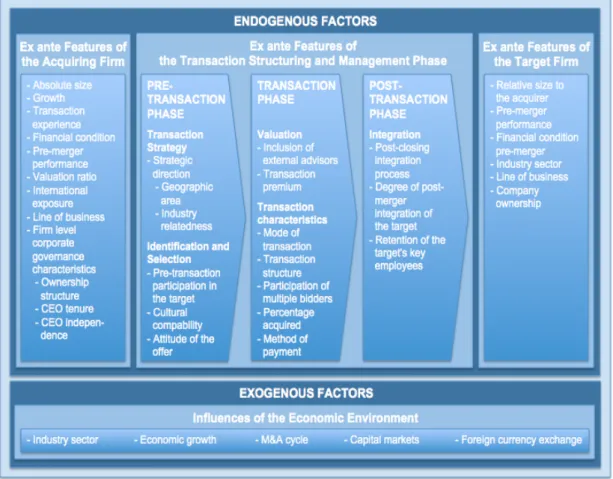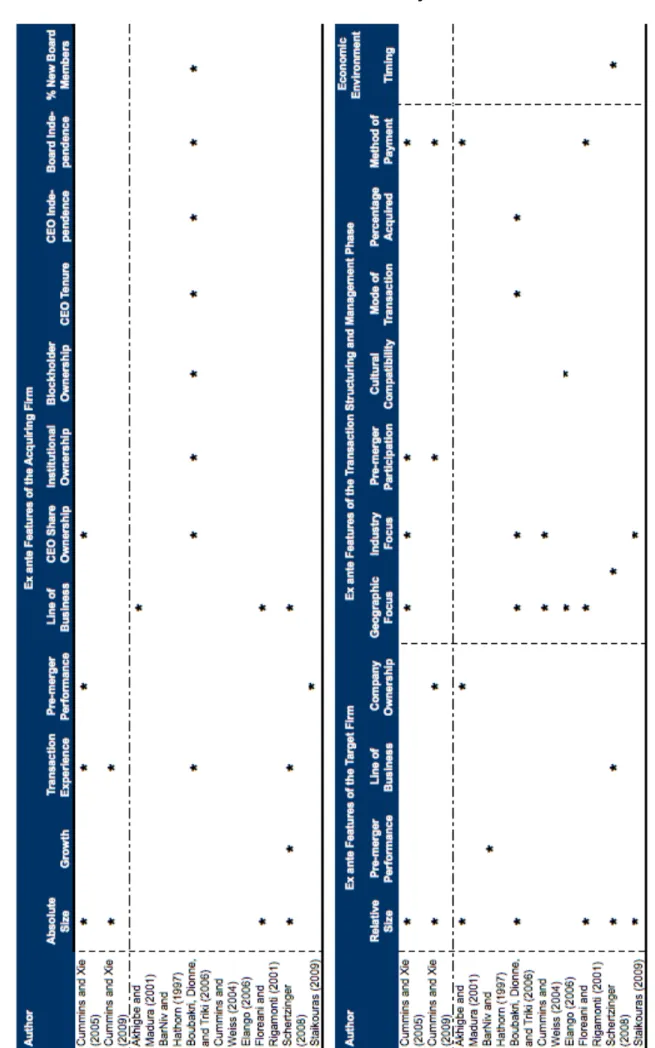Success of Mergers and Acquisitions in the Insurance Industry:
What Can We Learn From Previous Empirical Research?
Inauguraldissertation zur
Erlangung des Doktorgrades der
Wirtschafts-‐ und Sozialwissenschaftlichen Fakultät der
Universität zu Köln
2014 vorgelegt
von
Diplom-‐Kaufmann Sven Bach
aus Köln
Referent: Prof. Dr. Heinrich R. Schradin Korreferent: Prof. Dr. Dieter Hess Tag der Promotion: 30.06.2014
Table of Contents
Table of Contents ... III List of Abbreviations ... VII List of Figures ... XI List of Tables ... XIII
1 Introduction ... 1
1.1 History of the Consolidation Process and Relevance of the Topic ... 1
1.2 Problem Statement and Research Gaps ... 2
1.3 Research Objectives and Development of Research Questions ... 5
1.4 Organization of the Study ... 9
2 Theoretical and Methodological Background ... 11
2.1 Overview ... 11
2.2 Theoretical Foundations ... 11
2.2.1 Growth Options of Insurance Companies ... 11
2.2.2 Definition of the Term Mergers and Acquisitions ... 12
2.2.3 Categorization of M&A ... 17
2.2.4 Phases of the M&A Process ... 18
2.2.5 Overview of M&A Waves ... 22
2.3 Methodological Foundations ... 24
2.3.1 Definition of M&A Success ... 24
2.3.2 Traditional Approaches to Testing the Success of M&A ... 27
2.3.2.1 Financial Statement-Based Approach ... 28
2.3.2.1.1 Basic Procedure ... 28
2.3.2.1.2 Strengths and Weaknesses of the Measure ... 30
2.3.2.2 Capital Market-Based Approach ... 33
2.3.2.2.1 Basic Procedure ... 33
2.3.2.2.2 Strengths and Weaknesses of the Measure ... 35
2.3.2.3 Retention/Divestment Approach ... 40
2.3.2.3.1 Basic Procedure ... 40
2.3.2.3.2 Strengths and Weaknesses of the Measure ... 40
2.3.2.4 Interview and Survey Approach ... 42
2.3.2.4.1 Basic Procedure ... 42
2.3.2.4.2 Strengths and Weaknesses of the Measure ... 43
2.3.2.5 Concluding Evaluation of the Approaches ... 44
3 Literature Review: Prior Research on the Success of Insurance M&A and its Determinants ... 47
3.1 Overview ... 47
3.2 Overview of Recent Studies ... 47
3.3 Selection of Prior Research ... 55
3.4 Literature Review Method ... 57
3.5 Development of Research Clusters ... 59
3.6 Review of Individual Studies on the Overall Success of Insurance M&A by Cluster ... 63
3.6.1 Accounting Ratio Analysis ... 66
3.6.2 Efficiency Analysis ... 69
3.6.3 Linkage of Event and Efficiency Analysis ... 73
3.6.4 Event Analysis ... 75
3.6.5 Summary ... 87
3.7 Review and Results of Prior Capital Market Research on the Overall Success of Insurance M&A ... 88
3.7.1 Acquiring Firm Stockholder Returns ... 92
3.7.1.1 Short-Term Results ... 92
3.7.1.2 Medium- and Long-Term Results ... 95
3.7.2 Target Firm Stockholder Returns ... 99
3.7.2.1 Short-Term Results ... 99
3.7.2.2 Medium- and Long-Term Results ... 101
3.7.3 Total Stockholder Returns of Combined Firms ... 102
3.7.3.1 Short-Term Results ... 102
3.7.3.2 Medium- and Long-Term Results ... 105
3.7.4 Comparison of Short-Term and Medium- and Long-Term Results…… ... 105
3.7.5 Summary of the Evidence on the Overall Success of Insurance M&A…. ... 107
3.8 Review and Results of Prior Capital Market Research on the Determinants of M&A Success in the Insurance Industry ... 109
3.8.1 Overview ... 109
3.8.2 Characteristics of Acquiring Companies ... 115
3.8.3 Characteristics of the Target Companies ... 127
3.8.4 Characteristics of Transaction Structuring and Management ... 130
3.8.5 Influences of the Economic Environment ... 141
3.8.6 Comparison of Short-Term and Medium- and Long-Term Results….. ... 144
3.8.7 Summary of the Evidence on the Determinants of M&A in the Insurance Industry ... 146
4 Evidence from the European Insurance Sector: Empirical Analysis of the Success of M&A and its Determinants ... 149
4.1 Overview ... 149
4.2 Formulation of Hypotheses ... 154
4.2.1 Success of M&A in the European Insurance Industry ... 155
4.2.2 Determinants of M&A Success in the European Insurance Industry…. ... 156
4.3 Specification of the Empirical Study ... 163
4.3.1 Estimation Methodology ... 163
4.3.1.1 Overview ... 163
4.3.1.2 The Stochastic Dominance Model ... 169
4.3.1.3 Orders of Stochastic Dominance ... 170
4.3.1.3.1 First-Order Stochastic Dominance ... 171
4.3.1.3.2 Second-Order Stochastic Dominance ... 173
4.3.1.3.3 Kth-Order Stochastic Dominance ... 174
4.3.1.4 Testing for Stochastic Dominance ... 175
4.3.1.4.1 Descriptive Approach ... 175
4.3.1.4.2 Statistical Tests ... 178
4.3.1.5 Calculation of Returns ... 182
4.3.1.5.1 Short-Term Returns ... 182
4.3.1.5.2 Long-Term Returns ... 183
4.3.2 Operationalization of Determinants of M&A Success ... 186
4.3.3 Selection of Investigated Time Periods ... 191
4.3.4 Selection of Geographic Areas ... 192
4.3.5 Selection of Firms ... 192
4.3.5.1 Acquiring Insurance Firms ... 192
4.3.5.2 Control Firms ... 198
4.3.6 Selection of Investigated M&A Transactions ... 200
4.3.7 Procedure for Testing Stochastic Dominance ... 203
4.3.8 Generation of M&A and Reference Data ... 208
4.3.9 Extraction of Stock Prices ... 210
4.3.10 Characteristics of M&A Transactions ... 211
4.4 Results of the Empirical Study ... 217
4.4.1 Success of M&A in the European Insurance Industry ... 217
4.4.1.1 Results of Short-Term Analysis ... 218
4.4.1.2 Results of Medium- and Long-Term Analysis ... 222
4.4.2 Determinants of M&A Success in the European Insurance Industry…. ... 226
4.4.2.1 Characteristics of Acquiring Companies ... 227
4.4.2.2 Characteristics of Target Companies ... 235
4.4.2.3 Characteristics of Transaction Structuring and Management 240 4.4.2.4 Influences of the Economic Environment ... 249
4.5 Summary of the Findings of the Empirical Analysis ... 254
5 Conclusion ... 258
5.1 Summary ... 258
5.2 Limitations ... 260
5.3 Implications ... 264
Appendix ... 268
Figures ... 268
Tables ... 269
References ... 279
List of Abbreviations
€ Euro
# Number
% Percent
$ United States dollar
A Acquirer
AMEX American Stock Exchange
AR Abnormal return
AT Austria
AU Australia
avg. Average
B Benchmark
BE Belgium
BHAR Buy-and-hold abnormal return
BM Bermuda
bn Billion
BR Brazil
CAAR Cumulative average abnormal return CAPM Capital asset pricing model
CAR Cumulative abnormal return CBA Cross-border acquisition
CDF Cumulative distribution function CEO Chief executive officer
CER Combined entity return
CH Switzerland
cf. Confer
CoI Country of incorporation
CRSP Center for Research in Security Prices CTA Calendar-time (portfolio) approach CTAR Calendar-time abnormal return CTR Calendar-time return
D Day
DAX Deutscher Aktienindex (“German stock index”)
DE Germany
DEA Data envelopment analysis
DK Denmark
EDF Empirical distribution function
e.g. Exempli gratia
ES Spain
et al. Et alia
EU European Union
EUR Euro
FI Finland
FR France
GAAP General accepted accounting principles
GB Great Britain
GDP Gross domestic product
GICS Global Industry Classification Standard
H Hypothesis
HGB Handelsgesetzbuch (German GAAP)
ICB Industry Classification Benchmark
i.e. Id est
IE Ireland
IFRS International Financial Reporting Standards IPO Initial public offering
ISIN International Securities Identification Number
IT Italy
JE Jersey
KS Kolmogorov-Smirnov
LBO Leveraged buyout
LOF Liabilities of foreignness
L-t Long-term
LU Luxembourg
M&A Mergers and acquisitions
max. Maximum
min. Minimum
mn Million
M-V Mean-variance
MV Market value
n.a. Not available
NAIC National Association of Insurance Commissioners NASDAQ National Association of Securities Dealers Automated
Quotations
NL Netherlands
NO Norway
NYSE New York Stock Exchange
OECD Organization for Economic Cooperation and Development
p. Page
p.a. Per annum
PH Philippines
p.m. Per month
pp. Pages
P&C Property and casualty
P/L Property-liability
R Return
RE Reinsurance
RO Romania
ROA Return on assets
ROE Return on equity
RQ Research question
SD Stochastic dominance
SD1 First-order stochastic dominance SD2 Second-order stochastic dominance
SDC Security Data Company (by Thomson Financial)
SE Sweden
SFA Stochastic frontier analysis SIC Standard Industrial Classification S&P Standard & Poor’s
S-t Short-term
TRS Total return to shareholders
UK United Kingdom
US United States
USD United States Dollar
VaR Value at risk
vs. Versus
WACAR Weighted-average cumulative abnormal return
Y Year
List of Figures
Figure 1: Research structure ... 10
Figure 2: The definition of M&A in a broad and narrow sense ... 14
Figure 3: Structure of a typical M&A process ... 20
Figure 4: Criteria for categorizing M&A in the insurance industry ... 27
Figure 5: Overview of potential determinants of success of insurance M&A .. 113
Figure 6: Dependency between M&A success, an acquirer’s size and growth ... 117
Figure 7: Dependency between M&A success, an acquirer’s size, and transaction experience ... 119
Figure 8: Dependency between M&A success, an acquirer’s size, and transaction experience ... 121
Figure 9: Comparison of the influence of determinants of success of insurance M&A depending on time horizon ... 145
Figure 10: Applied criteria for differentiating success of M&A ... 153
Figure 11: Approach for derivation of hypotheses ... 155
Figure 12: First-order stochastic dominance of Fx over Fy ... 172
Figure 13: Second-order, but not first-order stochastic dominance of Fx over Fy ... 174
Figure 14: Testing procedure as applied in this work and interpretation of results ... 207
Figure 15: Number of M&A transactions and average M&A transaction volume in the final sample by year ... 217
Figure 16: Empirical CDFs of daily returns (0;+2D) – M&A versus benchmark portfolios ... 219
Figure 17: Integrated empirical CDFs of daily returns (0;+2D) – M&A versus benchmark portfolios ... 219
Figure 18: Empirical CDFs of buy-and-hold returns (0;+2Y) – M&A versus benchmark portfolios ... 224
Figure 19: Integrated empirical CDFs of buy-and-hold returns (0;+2Y) – M&A versus benchmark portfolios ... 224
Figure 20: Comparison of influence of determinants of insurance M&A success depending on time horizon ... 255 Figure 21: ICB and GICS structures for company classification ... 268
List of Tables
Table 1: Criteria for categorizing M&A ... 17
Table 2: Characteristics of the individual M&A waves ... 23
Table 3: Strengths and weaknesses of the financial statement-based approach ... 32
Table 4: Strengths and weaknesses capital market-based approach ... 39
Table 5: Strengths and weaknesses retention/divestment approach ... 41
Table 6: Strengths and weaknesses of the interview and survey approach ... 43
Table 8: Overview of prior research on the value effects of insurance M&A .... 59
Table 9: Prior research on the value effects of insurance M&A by cluster ... 62
Table 10: Data sources of the reviewed studies ... 64
Table 11: Criteria and sample characteristics of the reviewed studies ... 65
Table 12: Methodology of prior event study research on the value effects of insurance M&A ... 80
Table 13: Findings of prior event study research on the value effects of insurance M&A ... 91
Table 14: Overview of determinants of success analyzed in recent studies .. 114
Table 15: Results of determinants of value creation analyzed in recent studies ... 125
Table 16: Variable operationalization and formation of subsamples ... 191
Table 17: Overview of insurance companies in the final sample ... 197
Table 18: Overview of the generation of the data sample ... 209
Table 19: Overview of M&A transactions investigated in our analysis by acquiring insurance company ... 212
Table 20: Descriptive statistics of the final sample by year ... 215
Table 21: SD relation between M&A and benchmark portfolio ... 218
Table 22: Overall short-term results of SD approach ... 221
Table 23: Overall short-term results of event study approach ... 222
Table 24: Overall long-term results of SD approach ... 222
Table 25: Overall long-term results of event study approach ... 225
Table 26: Descriptive statistics for determinant subsamples ... 227
Table 27: Pairwise SD results: small versus large acquirers ... 229
Table 28: Pairwise SD results: negative versus positive growth of acquirers’
market values ... 231 Table 29: Pairwise SD results: M&A inexperienced versus medium experienced versus experienced acquirers ... 233 Table 30: Pairwise SD results: life/health versus property/casualty versus multi- line acquirers ... 235 Table 31: Pairwise SD results: small versus medium versus large relative deal size ... 237 Table 32: Pairwise SD results: life/health versus property/casualty versus multi- line versus banks/financial services targets ... 240 Table 33: Pairwise SD results: geographically focusing versus geographically diversifying transactions ... 241 Table 34: Pairwise SD results: industry-focusing versus industry-diversifying transactions ... 243 Table 35: Pairwise SD results: full-focusing versus full-diversifying versus mixed transactions ... 245 Table 36: Pairwise SD results: pre-M&A participation versus no pre-M&A participation ... 246 Table 37: Pairwise SD results: cash versus stock versus mixed payment ... 249 Table 38: Pairwise SD results: weak M&A market versus strong M&A market transactions ... 251 Table 39: Pairwise SD results: below-average GDP growth versus above- average GDP growth transactions ... 254 Table 40: Survey of studies ... 269 Table 41: Overview of Klaever’s efficiency results concerning the application of various tests on stochastic dominance ... 277 Table 42: Annual real GDP growth by expenditure ... 278
1 Introduction
1.1 History of the Consolidation Process and Relevance of the Topic
Similar to the general trend of increasing corporate expansion, the financial services industry, the insurance industry in particular, has experienced an unprecedented wave of mergers and acquisitions (hereafter, M&A) in the last 50 years.1 This ongoing transformation process can be attributed to several factors, such as improvements in computing and communication technology, changes in risk and interest rates, insurance premium deregulation, market saturation, and economic forces (Swiss Re, 1999, 2000; OECD, 2000; CEA, 2013b; Okura & Yanase, 2013). Moreover, the standardization of accounting rules (IFRS 4), the development of EU-wide solvency standards (Solvency II), the implementation of the euro, and the European Union’s Third Generation Insurance Directives in 1994, which deregulated the European insurance market, led to a rising number of cross-border EU transactions (transactions across national boundaries).2
Regulatory changes in the form of the EU’s Second Banking Coordination Directive of 1993 and later amendments, as well as the Gramm-Leach-Bliley Act in the US (1999), also helped push forward the integration of the financial services industry, resulting in an increasing amount of cross-industry transactions (deals involving companies of different industries, e.g., banks and insurers).3 As a result of this consolidation process, the number of financial services firms has declined substantially in recent years, although the number of insurance companies has remained fairly constant.4 This suggests that the restructuring process in the insurance sector was primarily conducted for
1 In this context, Fustec and Faroult (2011) provide the examples of the brilliant expansion of the French insurer AXA and the disastrous undertaking of Allianz buying Dresdner Bank.
2 See, e.g., Klumpes (2006 p. 2), Schertzinger (2008, p. 36), and Farny (2011, p. 168).
3 See, e.g., Group of Ten (2001), Cummins and Rubio-Misas (2003, p. 323), Fields, Fraser, and Kolari (2005, p. 777), and Focarelli and Pozzolo (2008, p. 1).
4 For example in the European insurance industry, the CEA reported that slightly more than 5,300 insurance companies were operating in Europe in 2012. Almost the same number (i.e., 5,391) was reported in the year 1997 (see CEA, 2013 and 1998, respectively). See also Schertzinger (2008, p. 16).
strategic purposes, such as to focus on a core business or geographical expansion into new regions, instead of consolidations in which the acquired insurer merged with the acquirer.5 In summary, corporate expansion through mergers and acquisitions has become an increasingly popular means of restructuring and repositioning in the global market; as such, M&A activity has become an important dynamic in the insurance landscape.
1.2 Problem Statement and Research Gaps
In light of the enormous economic importance and the high level of global M&A activity in the financial services, and in the insurance sector in particular, a plethora of research has addressed the economic justifications and effects of these M&A deals. From a theoretical standpoint, various academic arguments and rationales for value creation in M&A, as well as motives for insurance M&A, are addressed in the existing literature.6 Interestingly, in spite of this theoretical logic and the drastic increase in M&A activity in recent decades, there has been little empirical evidence of positive wealth effects and the success of M&A in the insurance sector as well as in the financial services industry. A plethora of research on M&A transactions in the banking industry regularly doubts value creation or even detects value destruction through this form of external restructuring.7
Likewise, empirical studies focusing on the insurance industry obtain inconsistent results regarding the success of M&A activity; therefore, the overall effect of such corporate activity remains controversial and inconclusive.
According to various authors,8 the vast majority of M&A transactions do not lead
5 See, e.g., Cummins, Tennyson, and Weiss (1998, p. 7) and Klumpes (2006, p. 19). In addition to this brief history of the consolidation process in the insurance industry, the subject has been more thoroughly discussed in the recent work of Schertzinger (2008).
6 For detailed information on drivers and hurdles as well as motives for M&A, see, for example, Pilloff and Santomero (1998, p. 61), BarNiv and Hathorn (1997, p. 105), Achleitner (2002, p.
142), Beitel (2002, p. 14), Sudarsanam (2010, p. 124), Cummins and Weiss (2004, p. 5), Cummins and Xie (2005, p. 6), Subramanyam (2005, p. 762), Boubakri, Dionne, and Triki (2006, p. 56), Klumpes (2006, p. 17), Cummins and Xie (2008, p. 32), Schertzinger (2008, p.
23), and DeYoung, Evanoff, and Molyneux (2009, p. 95).
7 See, e.g., the literature review of Young, Douglas, and Molyneux (2009) and cited references.
8 E.g., Marks (1988), Copeland, Koller, and Murrin (1990), Marks and Mirvis (1998), Chaigneau (1999), Sudarsanam and Mahate (2006), and The Boston Consulting Group (2009a).
to the desired increase in value and hence cannot be seen as successful.
Habeck, Kroeger, and Traem (2000) hence conclude that “[w]hile value creation might be the credo, value destruction is often the fact” (p. 3). In view of the constant rise in M&A activity over recent decades, this unfavorable finding leads to a paradox and consequently to the following questions being raised repeatedly in previous research9: (a) If M&A transactions in general are not successful, then why do companies continue to engage in M&A? (b) If M&A transactions on average are successful, then why have these positive effects not been revealed in prior M&A research? (c) Which determinants increase (or decrease) the probability of success in insurance M&A?
To answer these questions, one must first clearly define “success” and how it is measured. In general, there are various ways of measuring the success of M&A transactions. Major differences exist with regard to the choice of the success metric, the dimension of success, the timeframe for measuring success, the construction of the benchmark, and the perspective from which success is evaluated.10 According to numerous authors, these differences—in particular, the analysis from differing success perspectives (Meglio & Risberg, 2010), the widespread use of alternative success and performance metrics (Schoenberg, 2006), and differences in the timeframe of the studies (Schertzinger, 2008)—
may have held back knowledge development and may have at least been partly responsible for the mixed and contradictory findings of previous research.11 However, even if the same perspective is taken, the same methodology and measurement of success are applied, and the same time horizon is chosen, inconsistent findings between publications are the rule rather than the exception. For example, most capital market research on the success of insurance M&A has focused on the short-term effects of such corporate activity, however, yielding ambiguous results with respect to the average wealth effect of
9 E.g., Lubatkin (1983), Gregory (1997), Martynova, Oosting, and Renneboog (2006), Schertzinger (2008), among others.
10 Gerpott (1993, p. 190) and Wuebben (2007, p. 12). See section 2.3.1 for a further discussion on these various matrices and criteria.
11 E.g., Larsson (2004, p. 5), Schoenberg (2006, p. 2), Meglio and Risberg (2010, p. 89), and the references therein.
the acquirer.12 Also, the long-term effects of insurance M&A remain controversial, with only two capital market investigations, that is, Boubakri, Dionne, and Triki (2006) and Schertzinger (2008), finding contrasting results.
Boubakri, Dionne, and Triki (2006) provide empirical evidence for a strong positive relationship between M&A engagement and the financial success of acquiring insurance companies over a three-year post-M&A horizon. This contradicts the recent results of Schertzinger (2008), who finds the opposite relationship between insurance M&A transactions and long-term success.
Consequently, while general conclusions and recommendations for acquiring insurance companies cannot be made on the basis of findings from the extant insurance M&A literature, such information would be of great value for the decision making of managers, investors, and even regulators, as pointed out by Schertzinger (2008). In view of the controversial results in the published literature, some authors go even further by stating that no two M&A transactions are alike, thereby questioning the existence of general principles of success in M&A transactions.13 Haspeslagh and Jemison (1987) exaggerate the point by stating that “[n]othing can be said or learned about acquisitions in general” (p.
53).
Notwithstanding the problem of conflict regarding the average overall success of insurance M&A, the extant literature has identified a second problem area, namely the meaningfulness of the average overall result. One common finding is that in many cases, the average effect does not convey the substantial variation that exists between various M&A.14 Due to this great variety in M&A outcomes, the average value does not say much about the success of individual transactions. Consequently, in addition to the analysis of the overall effect of
12 For example, Cybo-Ottone and Murgia (2000), Fields, Fraser, and Kolari (2007), and Staikouras (2009) detect strong positive CARs for mergers of banks and insurance companies. Moreover, a positive short-term market reaction of insurance acquirers upon the announcement of pure insurance deals is found in the studies of Akhigbe and Madura (2001), Floreani and Rigamonti (2001), and Cummins and Xie (2005, 2009). In contrast, Cummins and Weiss (2004), Elango (2006), Schertzinger (2008), and Staikouras (2009) attain negative abnormal returns following the announcement of an M&A transaction.
13 See, e.g., Kitching (1973), Schubert (1981), Kusewitt (1985), Lubatkin (1987), and Bower (2001).
14 E.g., Merchant and Schendel (2000, p. 724), Akhigbe and Madura (2001, p. 496), and Schertzinger (2008, p. 98 & p. 133).
insurance M&A, earlier studies also investigate potential determinants of insurance transaction success that might help to explain the observed variations and differences in M&A outcomes. Unfortunately, a significant proportion of the extant literature does not include important influencing factors in the analysis or does not even conduct an analysis of the major influencing factors at all.
Moreover, previous research on this topic has not produced a consistent set of findings related to these influencing factors; hence, research has provided few insights into the significant correlations between the individual determinants and M&A success in the insurance industry. For example, the influence of the determinant “acquirer’s pre-merger participation in the target” is found to have a significant positive relationship to an acquirer’s post-merger performance in Cummins and Xie’s (2009) paper; however, their earlier work found a small negative relationship (Cummins & Xie, 2005). To summarize, it can be stated that little empirical evidence has addressed the potential influencing variables of M&A success in the insurance industry, and the available results have not given us many answers on how to increase the success rate of insurance M&A.
Against this backdrop and the results on the overall effect of insurance M&A, previous authors state that “research to this topic area shows a significant industry-specific gap,”15 and they postulate the need for further research on this topic, especially considering the huge practical relevance of M&A in the insurance industry.16
1.3 Research Objectives and Development of Research Questions
As portrayed above, despite decades of research, there are still many open questions regarding the success and the valuation effects of M&A transactions in the insurance industry. The most fundamental questions are whether M&A transactions in the insurance industry create value and which factors lead to value generation in insurance M&A, or in other words:
15 Schertzinger (2008, p. V). See also Merchant and Schendel (2000, p. 725), Javidan et al.
(2004, p. 257), Meglio and Risberg (2010, p. 88), and Antoniou, Arbour, and Zhao (2011, p.
18).
16 E.g., Merchant and Schendel (2000), Schertzinger (2008), and Cooper and Finkelstein (2010.)
(i) How successful are M&A transactions in the insurance industry?
(ii) Which factors increase the success of insurance M&A transactions?
Our work aims at answering these two fundamental questions or at least providing valuable insights into the overall success and the variables that potentially influence the M&A success of the acquiring insurance company. To achieve this, we break down these two fundamental questions into four research questions that allow for a better overview and that go as follows:
- RQ 1: What is the definition of M&A success and how can it be measured?
- RQ 2: Is it possible to develop a research cluster for the insurance M&A literature that is helpful in categorizing the findings of
previous studies?
- RQ 3: How successful are insurance companies in conducting M&A transactions?
- RQ 4: Which factors lead to successful M&A transactions in the insurance industry?
In order to provide an answer to these research questions, we first have to understand how M&A success can be defined and how it can be quantified and measured. This understanding is a necessary prerequisite for analyzing the effects of M&A transactions on the involved companies. Next, having gained the understanding of the term success and defined its use in this work, we ask the question: What does the previous empirical literature tell us about the success in insurance M&A and its influencing factors? However, in order to be able to give answers to this question and grasp the complexity inherent in the evaluation task, we have to structure the existing literature on the effects of insurance M&A. Accordingly, in a second step, we aim to develop a research cluster to categorize and structure the various findings of previous studies on M&A activity in the insurance industry. The third question concerns the overall success of insurance M&A transactions. Previous research on this topic has not come up with consistent answers regarding the average success rates, neither
in the announcement period nor in the medium- and long-term period. Our work therefore attempts to structure the diverse findings of recent insurance M&A research and thereby aims at understanding these seemingly contradicting results. Fourthly, we identify the potential influencing factors of M&A success that have been studied by the extant literature and outline the influences of these factors on the success of insurance M&A. The aim is to analyze why some insurance transactions succeed while others fail. Or, to put it in another way, this work investigates whether specific factors can explain the huge variations in the outcomes of individual M&A transactions and aims at identifying conditions under which M&A success in the insurance industry is increased or decreased. To further investigate the overall effect of insurance M&A and identify whether specific factors have a decisive influence on the success of these corporate undertakings, an empirical analysis of the relationship between M&A activity in the European insurance market and the financial success of these firms is conducted in the second major part of the book. By this we aim at testing the reliability and validity of the findings of previous research on the success of insurance M&A. This procedure—that is, first reviewing previous empirical literature and then conducting an own empirical analysis—enables us to approach research questions 3 and 4 in general17 and later on for a sample of 102 European insurance M&A transactions in particular.18
This work makes the following contributions relative to prior research on the success of insurance M&A:
First, even though various literature reviews on the performance and success of M&A transactions in the financial services industry (and in particular in the banking industry) exist, the work of Schertzinger (2008) is the first and so far only literature review that exclusively focuses on the success of M&A
17 For example, research question 3, in a modified form, is therefore: How successful are insurance companies in conducting M&A transactions in general?
18 Similarly, the modified research question 3 is thus: How successful have European insurance companies been in conducting M&A transactions during the period from 1993 to 2009?
transactions in the insurance sector. This existing insurance sector-specific literature review is not only extended by the inclusion of studies that were published after Schertzinger’s paper, but also by the supplemental analysis of numerous additional factors influencing the outcome of a transaction. Moreover, our work aims at identifying research clusters that may help to explain the mixed findings across studies.
Second, besides investigating the short-term market reaction following the announcement of an M&A transaction, our empirical study also explores the long-term success of insurance M&A and its influencing factors. The current capital market literature on the success of insurance M&A seems to be dominated by short-term investigations, and empirical evidence on the long- term success of insurance M&A transactions is virtually non-existent. To the best of our knowledge, the capital market research in this field only comprises two recent studies that produce opposite results. Hence, our work is only the third analysis that examines long-term performance based on stock market performance following M&A of insurance firms (and only the second that restricts its analysis to transactions of European insurance firms).
Third, so far, all capital market studies that analyze the success of M&A transactions in the insurance industry have used the standard event study procedure. However, as argued by Javidan et al. (2004) and many others, “the conflicting findings and the theoretical shortcomings in this approach point to the need for new and innovative thinking and methodologies” (p. 257).
Consequently, instead of adopting this traditional event study approach, we apply a fairly new approach to this problem and study the capital market reaction following the announcement of insurance M&A by using tests of stochastic dominance (SD). In this context, it is important to note that our work does not place particular emphasis on the statistical power of the SD test applied. Instead, our empirical study uses the SD approach to introduce an alternative measure for success evaluation.
1.4 Organization of the Study
The research structure of this study is directly derived from the above research questions. First, theoretical and methodological foundations for the analysis of success in insurance M&A are laid in order to enable a complete understanding of the investigated topic. Instead of producing another work on the theoretical justifications and rationales of insurance M&A activity,19 we directly deal with research question 1 about how success can be defined and measured. In this second chapter, we furthermore give particular attention to the various approaches for investigating M&A success. Following this, Chapter 3 presents a comprehensive overview of prior research on the success of insurance M&A activity and thereby seeks to provide at least some basis for tentative answers to research questions 2 to 4. This chapter contains a description of the literature review method that is used in our work. Afterwards, we develop research clusters to categorize the existing literature on the success of M&A deals (RQ 2), which is followed by a summary of the findings of earlier studies on insurance M&A by cluster. We examine the status quo (December 2013) of academic literature published in this field of research by bringing together the various findings of previous studies on the success of insurance M&A in a systematic way. The main purpose of this literature review is to brighten the picture by structuring the diverse findings and thereby helping to find potential explanations for the conflicting results of previous studies regarding M&A success. This comprehensive literature review is intended to help identify broad patterns in the insurance M&A literature and provide a solid perspective on the average success of an insurance transaction and then reveal particular specifics of individual transactions (RQ 3 and RQ 4). Moreover, this literature review serves as a foundation for the second major part of this book. In Chapter 4, we conduct an analysis on the success and the effects of M&A in the European insurance market and thereby provide supplemental evidence on this complex topic. In this way, we test the general findings from previous literature regarding the success of insurance M&A (RQ 3) and its influencing factors (RQ
19 This means that background information on the reasons for M&A activity in general and in the insurance industry in particular, as well as information on the relevant theories for explaining M&A activity, are not given herein. For this, the reader is instead referred to Boeckli (2003), Settnik (2006), Wirtz (2006), Wuebben (2007), Jansen (2008), and Boesecke (2009).
4) against a sample of European insurance transactions that were announced during the years 1993 to 2009. Lastly, in Chapter 5, we present the conclusions, highlight several important limitations, and discuss some of the implications of our results.
Figure 1 graphically depicts the structure of this work.
Figure 1: Research structure
2 Theoretical and Methodological Background
2.1 Overview
This chapter provides the conceptual and methodological framework for understanding and analyzing the success of M&A in the insurance industry.
First, the theoretical foundations are laid. We display basic growth options for companies, provide the terminological basis, summarize the several types of M&A transactions, and then illustrate the typical transaction process. As there is already a rich academic literature that extensively elaborates on the manifold motives for conducting M&A transactions and the underlying economic theories for explaining these deals,20 we will not cover these general issues in length herein, but these are taken into account when presenting and interpreting the results of our stochastic dominance analysis. Second, this study concentrates on the methodological prerequisites for evaluating the success in insurance M&A. A definition of value creation and success in M&A transactions is presented and differences in success perspectives, which could help to explain varying methodologies and results, are outlined. The various approaches and measures for evaluating and quantifying the success of insurance transactions are described in the final section of this chapter.
2.2 Theoretical Foundations
2.2.1 Growth Options of Insurance Companies
Corporate growth can occur in very different ways, as outlined, for example, in the academic papers of Hax and Majluff (1991), Canals (2000), Bausch (2003), and Boesecke (2009). In general, it can be achieved through both internal and external resources.21 In many cases, internal development will be considered
20 However, as highlighted by several authors (e.g., Weidenbaum & Chilton, 1988; Seth, Song,
& Pettit, 2002), the understanding of the various motives as well as advantages and disadvantages of M&A is a basic prerequisite for understanding and evaluating the success of M&A transactions. For a reader without the required background knowledge of the economic rationales behind M&A transactions in general and in insurance M&A in particular, we recommend the works of Cook (1988, p. 2), Albrecht (1994b, p. 5 & p. 27), Kerler (1999, p.
33), Weston, Mitchell, and Mulherin (2004, p. 130), Settnik (2006, p. 73), Schertzinger (2008, p. 23), Boesecke (2009, p. 15), and Eisenbarth (2013, p. 85).
21 See, e.g., Canals (2000), Schweizer (2002), Bausch (2003), and Boesecke (2009).
the preferred path, since it provides a cheap way for growth-seeking firms without involving substantial higher risks and uncertainty.22 When internal resources are scarce or particular growth targets can be achieved more quickly, growth can also be achieved externally through different forms of expansion, such as mergers and acquisitions and cooperative arrangements in which internal and external resources are used. Even though these external forms of corporate expansion pose formidable challenges for acquiring firms, they simultaneously offer effective opportunities that allow the respective acquirers to instantly expand business activities without having the need to build a complex organization internally. Further advantages of the external development route may comprise opportunities to enhance the capabilities of the respective firms, as well as opportunities for cost reduction and scale economies, financial and managerial synergy effects (from combining the two firms and running them more effectively), and tax advantages.23
In the subsequent section, we will first define the ominous term mergers and acquisitions in order to enhance the understanding of the various external growth opportunities—especially M&A as a specific form of external growth—
and then turn to the structure of a typical M&A process.
2.2.2 Definition of the Term Mergers and Acquisitions
Since the first takeover wave swept the United States in the beginning of the 20th century, the terms merger, acquisition and takeover are frequently used to describe the process of two separate companies coming together to form one bigger organization. As these terms are regularly used together or interchangeably in the finance literature and among practitioners dealing with this part of corporate finance,24 they are often incorporated under the generic
22 Weston, Mitchell, and Mulherin (2004, p. 137) and Jansen (2008, p. 171). See also Hayes and Garvin (1982, p. 5), who give several arguments against the path of external growth and for internal development.
23 E.g., Lubatkin (1983, p. 218), Kerler (1999, p. 38), Weston, Mitchell, and Mulherin (2004, p.
132), Weston, Chung, and Hoang (2007, p. 74), and Boesecke (2009, p. 1), and Farny (2011, p. 627).
24 See, e.g., Ansoff and Weston (1962, p. 56), Napier et al. (1989, p. 105), Floreani and Rigamonti (2001, p. 4), Wirtz (2003, p. 10), King et al. (2004, p. 187), Weston, Mitchell, and Mulherin (2004, p. 6), Jansen (2008, p. 91), and Cusatis, Miles, and Woolridge (2011, p. 529).
term mergers and acquisitions (or abbreviated as M&A).25 Consequently, it might seem that they all have the same meaning, but in fact, as pointed out by several authors,26 there are important differences between the words merger, acquisition, conglomerate, joint venture, takeover, and amalgamation. In order to clearly present the relationships between corporate expansion through M&A and financial performance and to meaningfully compare results of previous empirical research, it is however necessary to provide a precise definition of the terminology merger and acquisition and an understanding of the involved terms.
In absence of a consistent terminology, various attempts have been made to clearly specify these terms, resulting in a variety of definitions.27 In general, we can distinguish two groups of definitions based upon the range of corporate activities: Mergers and acquisitions (M&A) in a broad Anglo-American sense and M&A in a narrower Western sense. The broader definition includes a range of different transactions: “[t]he traditional subject of M&A has been expanded to include takeovers and related issues of corporate restructurings, corporate control, and changes in the ownership structure of firms.”28.29 Within Western M&A literature, “the term M&A is strictly confined to strategically motivated business combinations, i.e. transactions that result in the transfer of ownership as well as management and control rights from one company (the “target”) to another (the “acquirer”)”30. Further, Achleitner (2002) points out that under the narrow definition, all transactions conducted solely for financial investment purposes are excluded.
25 See, e.g. Brealey and Myers (1991 p. 817) and Wuebben (2007, p. 5).
26 E.g., Buono and Bowditch (1989, p. 60), Cartwright and Cooper (1992, p. 30), Epstein (2005, p. 37), Subramanyam (2005, p. 773), and Weston, Chung, and Hoag (2007, p. 3).
27 For example, Achleitner (2002, p. 141) states: “The term M&A refers to transactions in the market for companies, portfolios of companies’ assets, shares in companies and participations, and to the business segment of professional services firms or banks who consult transaction parties”. Sudarsanam (2010, p. 1), in contrast, defines M&A as deals “by which two companies are combined to achieve certain strategic and business objectives”.
28 Copeland and Weston (1988, p. 676). See also Herzel and Shepro (1990, p. 3), Hooke (1997, p. 1), Gaughan (2002, p. 7), and Weston, Mitchell, and Mulherin (2004, p. 5). An even wider definition is suggested by Sudarsanam (1995), who defines M&A as a “means of corporate expansion and growth” (p. 1).
29 See, e.g., Achleitner (2002, p. 141).
30 Wuebben (2007, p. 6). See also Wirtz (2003, p. 12), Lucks and Meckel (2002, p. 23), Mueller- Stewens, Spickers, and Deiss (1999, p. 1), and Vogel (2002, p. 5). Picot (2002, p. 15) extends the narrow focus of M&A by also including corporate events such as alliances, cooperations, and joint ventures.
To further illustrate the diverse areas that can be derived from the broad definition of M&A, as well as to outline the classification of M&A in a narrower sense, we adopt a model based partially on Copeland and Weston (1988) and partially on Nakamura (2005).31
Figure 2: The definition of M&A in a broad and narrow sense32
31 For differentiating the various types of M&A, we follow Wuebben (2007, p. 5), who adopts the perspective of companies using M&A as a strategy for growth rather than concentrating on the perspective of service providers, such as investment banks that provide advisory and other financial services for M&A transactions. For the latter, see Beitel (2004, p. 32).
32 Source: Adapted from Copeland and Weston (1988, p. 677), Gaughan (2002, p. 7), Nakamura (2005, p. 18), and Wuebben (2007, p. 6).
In this thesis, we do not present a detailed description of each individual area of M&A activity.33 Instead, we concentrate on the specific forms of M&A that will be used in this study.
If the term M&A is understood in the broad sense, it comprises manifold forms ranging from simple mergers and joint ventures to various types of corporate restructuring and changes in ownership structure. Hence, in the context of the previous M&A finance literature, using the broad definition of M&A activity could often lead to confusion and even misunderstanding, as argued by Nakamura (2005, p. 17). Consequently, we will look at M&A from the narrow perspective, considering only companies as acquirers.
The early definition of the OECD (1993), which characterizes a merger as “an amalgamation or joining of two or more firms into an existing firm or to form a new firm,” shall serve as a starting point.34 Technically, such a combination of operations can be done either through a “merger by absorption” or through a
“merger by establishment.”35 Merger by establishment is a situation in which two or even more entities (typically of similar size) are dissolved and merged into a completely new created company (e.g., JPMorgan Chase and DaimlerChrysler).36 According to Gaughan (2002), a consolidation, in which the target and acquiring firms become a new firm, can be considered to imply a merger by establishment. In an absorption merger, however, all assets of one or more company/ies are transferred to the absorbing company, and the absorbed companies are dissolved afterwards, as they become part of the acquirer.37 In the other type of business combination, namely in an acquisition, the acquirer purchases a significant share of stocks or assets of a (usually much smaller)
33 See, e.g., Copeland and Weston (1988, p. 676) and Jansen (2008, p. 94) for a detailed discussion.
34 For similar definitions of a merger, see, e.g., Gaughan (2002, p. 7) and Jagersma (2005, p.
14). Weston, Mitchell, and Mulherin (2004, p. 6) add in this context that the vast majority of mergers are friendly, negotiated transactions, even though negotiations sometimes start out hostile before turning friendly.
35 Chunlai, Chen, and Findlay (2003, p. 23) and Nakamura (2005, p. 18).
36 Chunlai, Chen, and Findlay (2003, p. 23) and Rui (2009, p. 10).
37 Chunlai, Chen, and Findlay (2003, p. 23) and Rui (2009, p. 10). In fact, such a form of merger could accordingly also be classified as an acquisition, as outlined by Nakamura (2005, p. 19).
target company to achieve a managerial influence (e.g., Cisco’s growth model).38 Consequently, such deals can be further divided into two major forms of acquisition: stock acquisitions and asset acquisitions. In the latter, the acquiring firm purchases some or all of the target firm’s assets while the former target stockowners receive cash for their shares. In stock acquisitions, however, stocks of the acquiring company are issued to a target’s shareholders in exchange for their stake in the target company. Depending on the stake the acquirer holds (and thereby its voting power) in the target following the acquisition, acquisitions are then classified into three types: complete takeovers (100% of the issued shares), majority position (less than 100% but more than 50% of the issued shares), and minority position (less than 50% of the issued shares).39 Nakamura (2005) outlines that even though the acquirer is assumed to have the power to influence the target’s business strategy in all three cases, the acquirer’s ownership (of voting rights) has to be above 50% to possess significant voting power to exert complete control over the target’s operations by being able to elect the board of directors as well as replace management.
Hence, acquisitions are characterized by the transfer of ownership, control, and voting rights, whereas a combination of the companies’ operations is obviously not a necessary condition to be classified as an acquisition.40
With the above discussion as background, it is clear that mergers and acquisitions are two forms of transactions that differ in regard to their transaction procedures, legal obligations, and tax liabilities.41 Thus, from a legal standpoint, a distinction between a merger and an acquisition is crucial,42 but from an economic and practical perspective, which is used in this study, it is redundant. In both cases, the involved companies ultimately combine their business efforts to realize some kind of benefit. In the context of this study, we
38 Chunlai, Chen, and Findlay (2003, p. 23), and Epstein (2005, p. 38).
39 Chunlai, Chen, and Findlay (2003, p. 23) and Nakamura (2005, p. 19).
40 This is a crucial difference to a merger, in which the operations of the involved companies are combined (e.g., Mueller-Stewens, Spickers and Deiss, 1999, p. 1; European Council, 2004 Art.
3 (1); Schertzinger, 2008, p. 4; Spiss, 2008, p. 1).
41 E.g., Buono and Bowditch (1989, p. 60), Cartwright and Cooper (1992, p. 30), Gerpott (1993, p. 27), Marren (1993, p. 77), Achleitner (2002, p. 141), and Rusu (2010, p. 12).
42 In a merger, the target is dissolved after the closing of the transaction. In an acquisition, the target company remains legally in existence after the transaction, e.g., Gerpott (1993, p. 30), Kerler (1999, p. 11), and Rusu (2010, p. 12).
accordingly follow the narrow interpretation43 of the term M&A and, moreover, do not distinguish between a merger and an acquisition.44 It is appropriate therefore, to make no differentiation between the terms merger, acquisition, transaction, and M&A and use them interchangeably throughout this study.
Further criteria for categorizing the various dimensions of these transactions are of much more interest. This will be dealt with in the subsequent section.
2.2.3 Categorization of M&A
Similarly to the definition of the generic term mergers and acquisitions, previous M&A literature offers a wide range of possible systematizations for types of M&A transactions. Table 1 displays these various dimensions for categorization.
Table 1: Criteria for categorizing M&A45
Criterion Characteristics
Attitude of the transaction Friendly, hostile
Competitive impact Beneficial, neutral, limiting
Duration Temporary, indefinite
Financing Equity, debt, hybrid
Geographic area Within-country, cross-border, transcontinental Industry relatedness Within-industry, cross-industry
Method of payment Cash, shares, others
Motive Profit, non-profit
Ownership status of the target Private, public
Status of the transaction Announced, pending, completed, withdrawn Strategic direction Horizontal, vertical, concentric, conglomerate Structure of the transaction Asset deal, share deal, portfolio transaction Type of business combination Acquisition, merger
43 See, e.g., Gerpott (1993, p. 22), Wuebben (2007, p. 7), and Schertzinger (2008, p. 7), who also adopt the definition of M&A in a narrower sense. Wuebben (2007, p. 7) adds that this procedure places the focus exclusively on companies as acquirers while transactions by private investors (e.g., by investor groups or through a management buyout) as well as strategic cooperations (e.g., joint ventures and alliances) are excluded.
44 We follow, for example, Wuebben (2007, p. 7) and Spiss (2008, p. 1), who do not make a distinction between these two terms.
45 Source: Pausenberg (1993, column 4438), Beitel (2004, p. 34), Eisenbarth (2013, p. 26) own research.
The most prominent dimensions by which M&A transactions can be categorized include the type of business combination, attitude of the transaction, geographic area, industry relatedness, payment method, and the ownership status of the target. However, as these various dimensions have been discussed extensively in several previous publications,46 we omit a detailed description at this point and will instead provide a more elaborate discussion on the few specific criteria that will become relevant when analyzing the success of insurance M&A and its determining factors (see Chapter 4).
2.2.4 Phases of the M&A Process
When analyzing value creation in insurance M&A and its influencing factors, we first have to grasp the manifold aspects of the M&A transaction process and its specific phases in order to provide a basis for evaluating the success of such corporate activities. Furthermore, Jemison and Sitkin (1986) highlight that “[t]he acquisition process itself is a potentially important determinant of acquisition activities and outcomes” (p. 145) and hence has to be portrayed in order to attain a comprehensive picture of the relevant issues.47
Given the complex challenges involved in conducting an M&A transaction, the popular M&A literature provides a variety of different structures for illustrating the typical transaction process from the perspective of the buying firm. These various structures of a friendly48 transaction differ mainly with respect to the number of phases and their respective denomination, as pointed out by Wuebben (2007, p. 39). While Boland (1970) and Schweiger and Weber (1989) subdivide the process of managing an M&A transaction only into two phases (pre-merger and post-merger or implementation, respectively), Hitt (2002), Parenteau, and Weston (2003), and Carpenter and Sanders (2007) divide the
46 For an in-depth discussion on the several categorization criteria, see, for example, Pausenberg (1993, column 4438), Gaughan (2002, p. 3), Beitel (2004, p. 34), Settnik (2006, p.
33), Wuebben (2007, p. 11), Jansen (2008, p. 99), and Schertzinger (2008, p. 7).
47 In addition, Haspeslagh and Jemison (1987) assert that “[b]y considering how this process affects the results, we believe managers may gain insights into ways to control negative outcomes” (p. 53).
48 Wuebben (2007, p. 39) notes that in hostile transactions as well as in auctions the transaction process regularly differs substantially from the one in friendly deals. The author refers here to the work of Picot (2002) for a description of such a hostile transaction process.
M&A process into four phases.49 Farley and Schwallie (1982) even use six phases (integration with the strategic plan, intelligent screening, evaluation of targets through creativity and analysis, understanding value and price, anticipating the post-acquisition phase, and efficient implementation), and seven phases (assessment, joint planning, issues analysis, structure selection, securing approvals, final planning, and implementation), respectively, to describe a typical transaction process. However, in the recent M&A research, a preferred structure has evolved that subdivides the acquisition process into three phases: pre-transaction phase, transaction phase, and post-transaction phase.50 This three-phase structure, as shown in Figure 3 below, is adopted for the purpose of this study and described in more detail hereinafter.51 However, as this structure represents a standardized transaction process, real-life processes might differ with respect to the individual steps and activities of these independent phases.52
49 Parenteau and Weston (2003): Strategy planning, candidate screening, due diligence and deal execution, and integration phase; Javidan et al. (2004): Strategic thinking and target identification, due diligence, negotiations, post-merger processes; Carpenter and Sanders (2007): Idea, justification, acquisition integration, and result appraisal.
50 E.g., Salus (1989): Premerger, merger, and post-merger; Von Krogh (1994): Pre-acquisition, acquisition, and post-acquisition; Dabui (1998): Premerger, merger post-merger; Appelbaum et al. (2000): Premerger, during, and post-merger; Picot (2002); Jansen (2008): Planning, implementation, and integration; Vogel (2002); Wirtz (2003); Richter (2005); Wuebben (2007):
Strategic analysis and conception, acquisition structuring and management, and post-closing integration; Schertzinger (2008): Planning, transaction, and integration.
51 Note that for an all-encompassing description of the individual transaction phases and the associated buy-side activities, please refer to the works of Wuebben (2007, p. 39), and Jansen (2008, p. 250).
52 Wuebben (2007, p. 39). See also Vogel (2002, p. 113) and Jansen (2008, p. 249).
Figure 3: Structure of a typical M&A process53
In the first phase of the M&A transaction process, the so-called “pre-transaction”
or “planning phase,” an insurance firm has to first formulate its corporate strategy and select its individual growth targets.54 If strategic gaps exist
53 Source: Wuebben (2007, p. 40), Schertzinger (2008, p. 11), own research. Presentation follows Jansen (2008, p. 249).
54 See Kerler (1999, p. 235), Wirtz (2003, p. 108), Wuebben (2007, p. 41), and Schertzinger (2008, p. 10). Note that this sentence and the remainder of the paragraph are mainly based on Javidan et al. (2004, p. 248), Wuebben (2007, p. 41), Schertzinger (2008, p. 10), and Boesecke (2009, p. 12).
